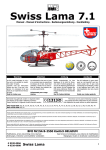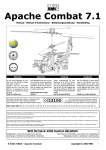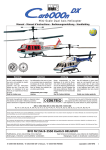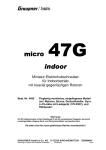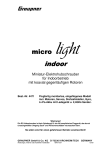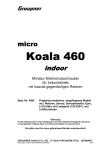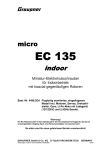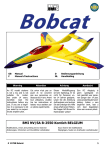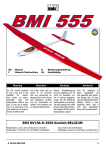Download Century Helicopter Products CENTURY LAMA 6 Specifications
Transcript
LAMA 6 CO-AXIAL100% READY-TO-FLY ELECTRIC HELICOPTER Specifications Main Rotor Blade Diameter..........................................................................................................340mm Length..................................................................................................................................................380mm Height..............................................................................................................................................165mm Weight.................................................................................................................................................240g Motor................................................................................................................................................. Dual Motor Battery...........................................................................................................................2S Li-Po (1000 mAh) Radio System.............................................................................4 Channel Helicopter Radio( Mode 2) Charger.........................................................................................................Standard AC Wall Charger Battery Balancer.......................................................................................................2 Cell Li-Po Balancer Century Helicopter Products - Copyright C All Rights Reserved - Version 1.0 June 2008 CENTURY LAMA 6 WARNINGS CAUTION K R/C Operating instructions • Check that all transmitter controls and Kontrollen vor der Flug • Stellen Sie sich sicher dass alle Trimmhebel gut positioniert sind, und Sender einschalten. • Empfänger einschalten. ug mit dem • Die Funktion vor Sender überprüfen. • Nach der Betrieb in umgekehrter Reihenfolge vorgehen. • Die Batterie herausnehmen und abklemmen. • Überprüfen ob alle Schrauben noch xiert sind. trims are in neutral. Make sure the throttle stick is down. Turn on the transmitter. • Switch on the receiver. • Inspect the servo throw and motor operations prior to taking off. • Reverse sequence when shutting ying. • Make sure to disconnect and remove the bat ying. • Check the model after ying and verify all screws are still fastened. cations / Main Rotor Diameter Length Weight Motor Size Radio Required Battery VORSICHT / Technische Daten a mèt Longueur fus agel e i e oa ml ac ne i h P ds d Moteur type Ra o i d Accu Hauptrotor Durchmesser 340 mm Rump änge 380 mm Gew chti ohne Accu 2 40 g Moto typr 180 size (2s) t nder Benö gtei Se 4 channel, heli Akku 7.4v, 1000mAh P.1 CENTURY LAMA 6 WARNINGS CAUTION VORSICHT Caution measures Use your radio controlled equipment only for the operations it has been made for. Avoid ying near high-tension lines and during rainy and/or windy days. Avoid ying in crowded areas Vorsichtmassnahme Benutzen Sie Ihre R/C Radioausrüstung nur für die Betriebe, wo sie für gebildet worden ist. Vermeiden Sie zu iegen, nah am Hochspannungslinien und während regnerischen und/ oder windigen Tage. Vermeiden Sie, in gedrängte Bereiche zu iegen. Beim Lesen Ihres Handbuches, sehen Sie die folgenden Symbole. Achten Sie immer besonderes auf die Punkte, in denen diese Symbole bildlich dargestellt werden und respektieren Sie immer ihre Bedeutung. While reading your manual, you will see the following symbols. Always pay special attention to the paragraphs where these symbols are depicted and always respect their cance. Strictly prohibited Test and verify Ausschliesslich verboten Testen und Überprüfen ight Never use the same frequency as someone else in your running area. Using the same frequency at the same time (either if it is AM, FM or PCM) can cause serious accidents, whether it’s ying, driving or sailing. Do not y outdoors and never y in rainy or windy days or at night. When ying in the rain, water may penetrate into the transmitter and will cause either faulty operation, lack of control and may cause a crash. Always extend the antenna to its full length to get the best possible transmission. Always extend the receiver antenna and hang it next to the fuselage if you want to obtain a transmission that is better then the 5-10 meters with the rolled up antenna. Always test the R/C set before use. Any malfunction in the R/C set or model may cause a crash. Before starting the motor, check that the direction of operation of each servo matches the operation of its control stick. If a servo does not move in the proper direction, or operation is abnormal, do not y the model. Vorsichtmassnahme während des Fluges Prüfen Sie, dass niemand in der Umgebung dieselbe Frequenz benutzt, den dadurch können Unfälle entstehen, auch bei einer unterschiedlichen Modulierung (PCHM/FM). Vermeiden Sie das Outdoor Fliegen, Fliegen bei Wind, Regenfall, Gewitter oder Dunkelheit. Wenn Nässe im Gehäuse sikkernt, kann es die Wirkung des Senders ernsthaft stören und einen Absturz verursachen. Antenne des Senders volständig herausziehen. Falls nicht völlig entfaltet hat der Sender nür eine beschränkte Reichweite. Antenne des Senders volsändig abwickelen wenn Sie eine grossere Reichweite wie 5-10 Meter haben wollen. Beobachten Sie immer Empfänger, Sender und Servo’s auf unregelmässigkeiten vór dem Fliegen. Ein Reichweitetest ist immer empfohlen. Falls verdächtige Erschütterungen oder unregelmässigkeiten auftreten, Fliegen Sie dann nicht mit das Model. Gebrauch vom Sender und Ladeakkus Inbetriebnahme Ihres Radios: 1. Motorschalter in neutral-Position bringen und Fernsteuersender einschalten. 2. Empfänger anschalten 3. Die Funktion vor iegen mit dem Sender überprüfen. 4. Nach dem Betrieb in umgekehrter Reihenfolge vorgehen. - Empfänger ausschalten - Fernsteuersender ausschalten. Instructions for safe use and proper charging R/C operation procedures: 1. Make sure the throttle control is in the lowest position, and switch on the transmitter. 2. Switch on the receiver. 3. Inspect the correct operation of your transmitter before use. 4. Reverse sequences to shut down after ying. - switch off the receiver - switch off the transmitter Gebrauch des Senderakkus adbaren Der Sender kann man mit wieder NiCad Batterien ausrüsten. Falls Sie wiederadbare NiCad-Batterien benützen, wenden Sie dann ein spezielles Ladegerät, dass man kaufen kann beim Fachhändler. Überladen der Batterie kann Brandwunden, Verletzungen oder Blindheit verursachen. Charging the transmitter batteries You can charge your batteries with a separately available charger. Please follow the instructions of the manufacturer before charging. It is also possible to use a separately available digital quick charger. Please pay close attention to the charger manual as overcharge can result in re and can harm skin and eyes due to overheating, breakage and electrolyte leakage. P.2 CENTURY LAMA 6 CONTENTS Kit contents Contenu de Kit Baukasteninhalt Stabilizer Stabilisierungsstange Main mast Hauptwelle Lower main rotor blades (B) (B) Untere Hauptrotorblätter (B) Upper main rotor blades (A) (A) Obere Hauptrotorblätter (A) Tail Heckteil Cabin Kabinenhaube Upper main rotor blades (A) (A) Obere Hauptrotorblätter (A) Charger and 1000mAh LiPo battery 100mAh Lader und 1000mAh LiPo Akku Now includes 2 cell Li-Po battery balancer! Transmitter / Sender 2 a. Lower main rotor blades (B) (B) Untere Hauptrotorblätter (B) LiPo battery LiPo Akku Caution Vorsicht Lithium polymer (LiPo) batteries require particular attentive treatment. This applies to charging, unloading, storage and other handling. Please pay special attention to the following instructions Please make sure to keep this manual always at hand. Improper treatment can lead to explosions, res, smoke development and poisonous danger. Neglecting the following safety and warning procedures will also lead to reduced battery performance. Cells with different capacities may not be connected in parallel or series, because the cell characteristics are too different. If however you connect LiPo batteries in parallel or series, Century refuses all warranty claims or damages that result from this operation. Century supplied LiPo batteries are therefore the only ones certified for use. Charge • Put the battery on a non flammable, heatproof and non conducting surface during the charging process. • Never charge the battery while it is situated in your model, and never charge it in Lithium-Polymer-Akkus (LiPo) bedürfen besonders aufmerksamer Behandlung. Dies gilt sowohl bei Ladung und Entladung als auch bei Lagerung und sonstiger Handhabung. Hierbei sind die folgenden besonderen Spekationen einzuhalten.Bitte bewahren Sie sorgfaltig diese Anleitung. Fehlbehandlung kann zu Explosionen, Feuer, Rauchentwicklung und Vergiftigungsgefahr Führen. Daneben führt die Nichtbeachtung der Anleitungs-und Warnhinweise zu Leistungseinbussen und sonstigen Defekten. Zellen mit verschiedene Kapazitäte dürfen nicht in Reihe und nicht parallel geschaltet werden, da die Eigenschafte und der Ladezustand zu unterschiedlich sind. Wenn Sie doch Akkupacks in Reihe oder parallel schalten, verweigert Century alle Ansprüche oder Beschädigungen. Von uns gelieferte Akkupacks sind deshalb selektiert. P.3 Ladung • Während des Ladevorgangs den Akku auf einer nicht brennbaren, hitzebeständige und nicht leitenden Unterlage legen. • Nie den Akku in den Model oder im Nähe CENTURY LAMA 6 CHARGING • • • • • • the neighborhood of ammable or easily ammable products. Always charge the batteries under supervision. Only use chargers that are capable of charging LiPo batteries. Never charge the battery in an operating vehicle (car, motorbike, ...). Should the battery become too warm, remove it immediately from the charger. Never connect the batteries with a wrong polarity. Charge the cells with max. 1C (value of 1C = cell capacity) charging current. • • • • • • von brennbare oder leicht entzündliche Gegenstände laden. Laden Sie die Akkus nur unter Aufsicht. Akkus nie in ein Fahrzeug (Auto, Motorrad,...) laden. Gebrauchen Sie nur fur LiPo Akkus geieignete Lader. Sollte den Akku zu warm werden, entfernen Sie den Akku sofort vom Lader. Achten Sie immer darauf dass die Akkuzellen mit richtiger Polarität angeschlossen werden. Laden Sie die Zellen mit max. 1C (Wert von 1C = Zellenkapazität) Ladestrom. Storage • LiPo cells are to be stored with a charged capacity of 80% (3.0V per cell). If you don’t leave them partialy charged, they will become useless. Do not discharge the battery too low because it will be defective. Only use your model for 10-12 minutes at a time. • LiPo cells are more fragile then batteries in metal housings. Make sure to avoid shock. If the battery suffers shock or the model has been damaged in a crash remove the battery from the model. Leave it for at least 30 minutes on a non flammable and heatresistant surface. • All contact with any kind of liquid should be avoided. • Never take a LiPo battery pack apart. Lagerung • LiPo Zellen sollen mit einer eingeladenen Kapazität von 20% gelagert werden, so nicht wird den Akku nach einige Zeit unbrauchbar. Der Akku soll nie unter 3.0V pro Zelle entladen werden, so nicht wird den Akku unbrauchbar. • LiPo Akkus sind mechanisch nicht so stabil wie Akkus in Metallgehäusen. Vermeiden Sie daher Shocks. Wenn den Akku einen Schock bekommt, entfernen Sie es vom Modell und lassen Sie es während mindestens 30 Minute auf einer nicht brennbaren und hitzebeständige Unterlage liegen. • Jeder Kontakt mit Flüssigkeit gleich welcher Art ist zu vermeiden. • Zerlegen Sie niemals einen LiPo Akku. Recycling • If a LiPo battery gets damaged (punctured casing, ...) please follow the next procedure : Discharge battery – Cool down battery – Emerge battery for several hours in a salted water bath – Hand over battery to a ed battery recycling center. Recycling • Wenn ein LiPo Akku Defekt ist (beschädigte Folie), folgen Sie dann diese Schritte : Akku entladen – Akku abkühlen lassen – Akku während einige Stunden in eine Salzwasserlösung eintauchen – Akku bei ein ziertes Recyclingzentrum eingeben. Since Century can not supervise the correct charging, unloading and storage, any warranty resulting from improper charging, unloading or storage is excluded. Century refuses all possible warranty claims and/or damage claims caused by use of these batteries. Da die Firma Century die richtige Ladung, Entladung und Lagerung nicht überwachen kann, wird jegliche Garantie bei Fehlerhafter Ladung, Entladung oder Lagerung ausgeschlossen. Century verweigert alle mögliche Ansprüche und/oder Beschädigungen die durch Gebrauch dieser Akkus verursacht werden. 2 b. Charging LiPo battery Charger l’accu LiPo LiPo Akku lade D B C Battery Balancer A METAL BOX P.4 CENTURY LAMA 6 FLIGHT PREPARATION 4 Flight preparation Flugvorbereitungen The “4-in-1 Unit” is a device with a receiver, gyro, mixer and ESC built-in one box. Our factory has installed the “4-in-1” Unit and connected main motors, battery pack and two servos to the Control-box. The 4-in-1 Unit is equipped with a fail safe device. If the battery is connected to the 4 in 1 Unit without having turned on the transmitter, the helicopter will refuse to operate. The same applies if the throttle stick and/or the throttle trims are not properly positioned. Die “4 in 1” Einheit enthält Gyro, Mischer, Empfänger und zwei Drehzahlsteller in einem Gehäuse. Sie ist bereits eingebaut und beide Motoren, beide Servos und der Stromversorgungsstecker sind daran angeschlossen. Die Einstellregler “Gyro Trim” (für der Gyro) ist werkseitig voreingestellt. Die 4 in 1 Einheit ist mit einer Fail-Safe Sicherheit ausgerüstet. D.h. wenn Sie der Akku anchliessen ohne der Sender ein zu schalten, der Hubschrauber nicht funtionieren wird. Wenn Sie der Gasstick und/oder Gashebel nicht richtig positioniert haben wird der Heli auch nicht funtionieren. 1. VERY IMPORTANT: Before turning the transmitter on, set the throttle stick as well as its trim to the lowest (power off) position. The trim of the elevator and aileron sticks should be set to neutral position. 2 & 3. Turn the transmitter on and extend the antenna. 4. Installation of the Battery Pack ; shove the battery into the battery tray and connect the cables while paying attention to the polarity. 5. ash immediately. If the LED lights up, the helicopter ashes slowly, the battery voltage is low, and you will ying and recharge the battery. & 3.1 Korrekt alle Trimmscheiber auf Mitte stellen. Gasknüppel auf „Nullposition“. Sender einschalten. Achten Sie darauf dass alle Servo-Reverse Tasten auf die richtige Positionen stehen. & 4.2 Sender einschalten und Antenne ausschieben. 5. Akku einschieben wie abgebildet. Die6.Batterie mit dem Mixer-Fahrtregler verbinden, 1 bis 2 Sekunden warten bis die Elektronik aktiv ist. Die grüne LED wird blink euchten. Dies bedeutet dass die elektronischen Anschlüsse korrekt sind und dass die Elektronik aktiv ist. Ihr Gasknüppel auf „Stop“ halten und die Funktionsrichtung der Steuerungen überprüfen. Am Nickknüppel ziehen um zu sehen ob die Taumelscheibe korrekt reagiert. Nochmals überprüfen ob alle Bauteile richtig sitzen. Leuchtet der grüne LED schnell, soll man unbedingt landen und Akku laden. Nach dem Flug, trennen Sie den Akku vom 4in1 und schalten Sie dann den Sender aus. 1. 2. Antenna Servo reverser Power switch 3. An/Aus Schalter 5. Green LED LED Grüner LED Gyro Trim 4. P.5 CENTURY LAMA 6 CONTROLS ight 5a. Erster Flug Stick operation Senderfunktionen P.6 CENTURY LAMA 6 FLIGHT 6 1. Put the helicopter on a smooth surface which allows the model to slide and turn around. 2. Set the throttle stick and its trim lever to the lowest position (power off). DO NOT TOUCH THE SERVO REVERSER SWITCHES. rst. Connect the 3. Turn on the transmit battery pack to the “4 in 1” Control-box. The LED will blink green. Wait until it lights up green. 4. Set the Rudder Stick as well as its Trimmer to the neutr rst. Gently push the throttle up until the skids are about to leave the ground. 5. Never push the throttle stick to full power or push it abruptly. Continue to practice “take off and landing” until you become familiar with the procedure. (5.1) 6. Increase power little by little and let the machine take off up to 12-16 inches. This ying as the “ground effect” makes the helicopter become unstable (5.2). The machine will shift away quickly in an unexpected direction. Observe the direction it shifts towards. If it is shifting to the left, correct it by moving the aileron trim lever a little to the right. If it is shifting backwards, push the elevator trim lever a little forward. If it turns to the right, push the rudder trim lever a little to the left. And so on. 7. Then, gently push the throttle stick forward a little more to lift up the machine to your knee-height (5.3). You have to carefully correct the machine so as to not shift away by simultaneously pushing or pulling the elevator, aileron and rudder stick to eliminate the shift. 8. Next, push the throttle stick further forward to raise the helicopter to your eye-level. If the machine should shift in any direction, gently move the rudder, elevator and aileron sticks in the opposite direction of the movement to return the machine to its original position. Congratulations! you have succeeded in “Hovering”. y the your heli in different 9. Now, y y forward or backward, y to the left or to the right (5.4A/B), y higher or lower, etc. After practicing enough, you can do more, such as: Pirouette rotations in hover), Square Patterns, Landing on Designated Spots, etc. 10. Should the helicopter crash, immediately pull the throttle stick and set the trim lever to the lowest position and disconnect the rst, then turn off your transmitbat ter to avoid damage to the helicopter and/or the electronics and radios. 1. Der Heli auf einen ebenen Untergrund stellen, der es ihm erlaubt zu rutschen und sich zu drehen. 2. Den Rotorschub-Steuerknüppel und den zugehörigen Trimmhebel in die unterste Position (Motor Aus) bringen; die anderen Bedienelemente so belassen wie zuvor eingestellt. 3. Zuerst Sender einschalten, dann den Akku an die 4/1 Einheit anschliessen: die LED blinkt zunächst grün. Warten Sie bis sie konstant grün leuchtet. 4. Vorsichtig die Schubsteuerung nach vorn schieben, bis die Kufen gerade vom Boden abheben wollen und das Modell sich nach rechts oder links wegdreht. Wenn nu reine kleine Korrektur erforderlich ist um das Drehen zu beenden soll das mit dem Gier-Trimmhebel passieren. 5. Niemals den Schubsteuerknüppel auf Vollgas schieben oder abrupt betätigen. So lange üben, bis das Abheben und Aufsetzen funktioniert (5.1). 6. Den Schub in kleinen Schritten erhöhen so dass das Modell 30-50cm hoch abhebt. In dieser Höhe macht sich der sogenannten Bodeneffekt (5.2) bemerkbar der das Modell instabil werden lässt. Dadurch wird das Modell in unterschiedliche Richtungen davondriften. Die Bewegungen mit den Steuerknüppeln abstoppen und mit den Trimmhebeln so nachtrimmen dass das Modell auf einer Stelle stehen bleibt und höchsten langsam davondriftet. 7. Jetzt den Schub weiter erhöhen und das Modell auf Kniehöhe (5.3) steigen lassen. Dabei muss ständig mit den drei Steuerfunktionen Rollen, Nicken und Gieren korrigiert werden, damit das Modell nicht driftet. 8. Nun den Schub weiter erhöhen und das Modell auf Augenhöhe steigen lassen. Dabei weiterhin ein Wegdriften des Modells durch kleine, zur Bewegungsrichtung entgegengesetzte Steuerausschläge verhindern. Damit be ndet sich das Modell im Schwebe ug. 9. Nun kann der Hubschrauber bewusst in alle Richtungen ge ogen werden; Vorwärts, Rückwärts, nach links-rechts, höher oder niedriger, … (5.4A/B). Mit mehr übung lassen sich alle weiteren Schwebe ugmanöver iegen, wie beispielweise Pirouetten, Rechteck, Schwebeug-8, Ziellandungen, etc. 10. Wenn das Modell während des Fluges bei Schuberhöhung plötzlich unkontrollierbar wegzudrehen beginnt und dabei die Leuchtdiode an der 4/1 Einheit rot au euchtet, ist das ein Anzeichen dafür dass der Akku leer ist: Es muss unverzüglich gelandet werden. 11. Sollte es einmal zu einem Absturz kommen, muss sofort die Schubsteuerung und der zugehörige trimmhebel in die Motor Auspostion gebracht werden. Dann soll der Akku abgezogen und als letztes der Sender ausgeschaltet werden um weitere Schäden an Hubschrauber und Elektronik zu vermeiden. 5.2 P.8 P.7 CENTURY LAMA 6 TRIMMING 6.2 6.3 6b. Trimming the swashplate Trimmung Taumelscheibe A: This adjustment can be used to trim out the ailerons and controls the right and left movement of the helicopter. This setting can be changed with the transmitter or mechanically. A: Mit dieser Feinabstimmung kann die links/ rechts Funktion des Hubschraubers getrimmt werden. Dieser Abstimmung kann auch über der Sender gemacht werden. B: Der SSSS System (Superstabiler gleitender Taumelscheibe) determiniert die Stabilität der untere Rotorblätter. Über dieser Funktion kann der Hubschrauber noch stabiler gemacht werden. Die Schraube soll so angedreht werden dass die Taumelscheibe noch frei bleibt. B: The Swashplate System controls the stability of the lower main blades. Setting up the swashplate properly can make the helicopter even more stable. C: Adjusting the lengths of the pushrods for left, right, forward, and back movment. Making the swashplate level to the ground at will make the helicopter fly the most neutral. Getting the pushrods even in length will help left and right movements to be stable. C: Dieser Feinabstimmung hat ein Ein uss auf die vorwärts und rückwärtsgang des Hubschraubers. Trimm auf neutral setzen. A C B P.8 CENTURY LAMA 6 TROUBLESHOOTING 7 Co-Axial System Koaxial Rotorsystem Instead of using a tail rotor to counter the main rotor torque, the co-axial counter-rotating system has two main rotors, one above the other, turning in opposite directions. This makes it possible to balance the torque of the two rotors so that the fuselage won’t be steered during hovering or in straight ight. Anstatt das Hauptrotordrehmoment mit einem Heckrotor auszugleichen, besitzt das koaxial gegenläu ge Rotorsystem zwei Hauptrotoren, die über einander angeordnet in entgegengesetzte Richtungen drehen. Das ermöglicht es, dass sich die Drehmomente der beiden Rotoren gegen einander ausgleichen, so dass sich der Rumpf weder im Schwebe ug, noch im Vorwärts ug unbeabsichtigt um die senkrechte Asche dreht. Since the two rotors are separately driven by the two motors, by increasing the speed of one motor and decreasing the speed of the other, the torque of two rotors will differ from each other and steer the fuselage to turn the helicopter left or right. In other words, the helicopter can turn while hovering or in ight. The speed of the motors is controlled by the throttle stick and the rudder stick on the transmitter. When you push the throttle stick forward towards full power position, the speed of both upper and lower motors increases. Hence the speed of both upper and lower rotor blades increases. But, when you push the rudder stick to the left or to the right, the speed of one motor increases and the speed of the other motor decreases. Hence the speed as well as the torque of one rotor increases and the torque of another rotor decreases. Therefore, the fuselage will be steered and make the helicopter turn to the left or to the right. In other words, rudder stick is used to control the helicopter to turn around in hover, or to turn to the left or to the right during ight. Just like helicopters with single main rotors and a tail rotor, the elevator stick controls the helicopter to y forwards or backwards. And, the aileron stick is used to roll the helicopter to the left or to the right. These are carried out by the servos linked to the swashplate which in turn tilt the lower rotor disc so as to make the helicopter y forwards or backwards, to the left or to the right. Da die beiden Rotoren von separaten Motoren angetrieben werden ist es möglich, durch Erhöhen der Drehzahl des einen und Verringern der Drehzahl des anderen Motors unterschiedliche Drehmomente (bei gleichbleibendem Gesamtschub) zu erzugen, was zu einer Drehung des Rumpfs um die vertikale Achse führt. Dieses nutzt man anstelle des Heckrotors bei normalen Hubschraubern für Drehungen im Schwebe ug und Richtungsänderungen im Vorwärts ug. Die Drehzahlen der Motoren werden am Sender sowohl mit der Rotorschubfunktion als auch mit der Gierfunktion gesteuert: drückt man den “Gas”Steuerknuppel nach vorn, so erhöht sich die Drehzahl an beiden Motoren und damit auch an beiden Rotoren gleichermassen. Wenn man dagegen den Steuerknüppel für die Gierfunktion nach rechts oder links drückt, erhöht sich die Drehzahl an einem Motor, während die sich am anderen Motor verringert. Weil sich damit auch die Drehzahlen der beiden Rotoren und damit die Drehmomente gegensinnig verändern, dreht sich entsprechend der Rumpf des Hubschraubers nach rechts oder nach links. Genau wie bei einem normalen Hubschrauber mit Haupt- und Heckrotor steuert der Steuerknüppel für die Nickfunktion das Fliegen vorwärts und rückwärts und der Steuerknüppel für die Rollfunktion das Fliegen nach rechts und links. Das wird dadurch erreicht, dass die beiden mit der taumelscheibe verbundenen Servos die Rotorebene des unteren Rotors entsprechend neigen wodurch der Heli dann in die gewüschte Richtung iegt. Problem solving Fehlerlösung Helicopter does not move The charger isn’t properly plugged in or is malfunctioning. Battery is empty Check the connection of the battery Check if the transmitter is on and if the frequency is correct Charge the battery Helicopter reagiert nicht Akku nicht geladen Akkustecker kontrolieren Schalter kontrolieren Akku laden Servos bewegen aber Hubschrauber bewegt sich nicht Motor überhitzt oder kaputt Motor abkühlen lassen. Falls Problem nicht gelöst wird, Motoren ersetzen Battery cannot be charged. Battery is discharged too low. Battery must not be discharged under 6.0V, otherwise battery will be damaged. Only y the model no longer than 12 minutes. If battery doesn’t work, replace the battery. Mini Lama bewegt unkontrollierbar Slechte Trimmung oder Zugluft Trimmung reglen und/oder Türen schliessen/ Airco abschalten Servos are working, but the motor is not running Motor is worn. Motor is overheated. Let the motors cool down. P.9 CENTURY LAMA 6 TROUBLESHOOTING Hubschrauber will nicht aufsteigen Motor überhitzt Akku fast leer Motoren abkühlen lassen und eventuell ersetzen Akku laden The helicopter moves left, right, forward Trim is not adjusted. Windows might be open or room fans might be blowingtoo hard. Adjust the trim. The helicopter can’t y when there is wind. Close the windows and or turn off the room fans. Akku will nicht laden Akku unter 6.0V entladen Akku defect, Akku ersetzen. The helicopter does not want to take-off Motor overheated. Battery empty. Let the motors cool down. If the problem persists, change the motors. Charge the battery. P.10 CENTURY LAMA 6 PARTS DIAGRAM 15 08A 17 03 22 03 12 08A 21 15A 08B 11 02 08B 16 20 13 19 09 18 05 26 26 20 14 01 04 15 40 25 10 24 21 06 07 P.11 CENTURY LAMA 6 PARTS LISTING DIAGRAM REF PART # DESCRIPTION (1)........................................................CLM6-01 MAIN FRAME (2)........................................................CLM6-02 LOWER MAIN BLADE GRIPS (3)........................................................CLM6-03 UPPER MAIN BLADE GRIPS (4)........................................................CLM6-04 SERVO W/TAPE (5)........................................................CLM6-05 TAIL TRUSS COVER (6)........................................................CLM6-06 LANDING GEAR SET (7)........................................................CLM6-07 BATTERY HOLDER (8A).....................................................CLM6-08A MAIN BLADE SET-UPPER (8B).....................................................CLM6-08B MAIN BLADE SET-LOWER (9)..................................................... CLM6-09 CONTROLLER 4-IN-1 (10).....................................................CLM6-10 TAIL ROTOR BLADE (11).....................................................CLM6-11 ROTOR HEAD (12).....................................................CLM6-12 AXLE TREE (13).....................................................CLM6-13 VENT PIPE (14R)..................................................CLM6-14R CABIN-RED (14Y)..................................................CLM6-14Y CABIN-YELLOW (15).....................................................CLM6-15 TIE BAR (2) (15A)..................................................CLM6-15A TIMING PLATE BAR (2) (16).....................................................CLM6-16 TILTING PANEL (17).....................................................CLM6-17 FLYBAR W/WEIGHT (18).....................................................CLM6-18 MAIN MOTOR PLATE (19).....................................................CLM6-19 B. BEARING(2)-UP/DOWN AXLETREE (20).....................................................CLM6-20 MAIN MOTORS (2) W/GEAR (21).....................................................CLM6-21 SIDE FRAMES (2) (22).....................................................CLM6-22 ROTOR HEAD W/INNER SHAFT (24).....................................................CLM6-24 INNER GEAR SET (25).....................................................CLM6-25 B. BEARING SET-INNER GEAR (26).....................................................CLM6-26 OUTER MAIN SHAFT SET (27).....................................................CLM6-27 LIPO CHARGER-7.4V 1000MAH (NOT SHOWN) (29).....................................................CLM6-29 BALANCING CHARGER (NOT SHOWN) (30).....................................................CLM6-30 7.4V 1000MAH 2-CELL LIPO (NOT SHOWN) (31).....................................................CLM6-31 TRANSMITTER 4 CHANNEL (NOT SHOWN) (33).....................................................CLM6-33 USB SIMULATOR CABLE (NOT SHOWN) P.12 CENTURY LAMA 6 WARRANTY & LIMITATIONS Warranty Period Century Helicopter Products warranties that the Products purchased will be free from defects in materials and workmanship at the date of purchase by the Purchaser. Limited Warranty (a) This warranty is limited to the original Purchaser (“Purchaser”) and is not transferable. REPAIR OR REPLACEMENT AS PROVIDED UNDER THIS WARRANTY IS THE EXCLUSIVE REMEDY OF THE PURCHASER. This warranty covers only those Products purchased from an authorized Century Helicopter Products dealer. Third party transactions are not covered by this warranty. Proof of purchase is required for warranty claims. Further, Century Helicopter Products reserves the right to change or modify this warranty without notice and disclaims all other warranties, express or implied. (b) Limitations- CENTURY HELICOPTER PRODUCTS MAKES NO WARRANTY OR REPRESENTATION, EXPRESS OR IMPLIED, ABOUT NON-INFRINGEMENT, MERCHANTABILITY OR FITNESS FOR A PARTICULAR PURPOSE OF THE PRODUCT. THE PURCHASER ACKNOWLEDGES THAT THEY ALONE HAVE DETERMINED THAT THE PRODUCT WILL SUITABLY MEET THE REQUIREMENTS OF THE PURCHASER’S INTENDED USE. (c) Purchaser Remedy- Century Helicopter Product’s sole obligation hereunder shall be that Century Helicopter Products will, at its option, (i) repair or (ii) replace, any Product determined by Century Helicopter Products to be defective. In the event of a defect, these are the Purchaser’s exclusive remedies. Century Helicopter Products reserves the right to inspect any and all equipment involved in a warranty claim. Repair or replacement decisions are at the sole discretion of Century Helicopter Products. This warranty does not cover cosmetic damage or damage due to acts of God, accident, misuse, abuse, negligence, commercial use, or modification of or to any part of the Product. This warranty does not cover damage due to improper installation, operation, maintenance, or attempted repair by anyone other than Century Helicopter Products. Return of any goods by Purchaser must be approved by Century Helicopter Products before shipment. Damage Limitations CENTURY HELICOPTER PRODUCTS SHALL NOT BE LIABLE FOR SPECIAL, INDIRECT OR CONSEQUENTIAL DAMAGES, LOSS OF PROFITS OR PRODUCTION OR COMMERCIAL LOSS IN ANY WAY CONNECTED WITH THE PRODUCT, WHETHER SUCH CLAIM IS BASED IN CONTRACT, WARRANTY, NEGLIGENCE, OR STRICT LIABILITY. Further, in no event shall the liability of Century Helicopter Products exceed the individual price of the Product on which liability is asserted. As Century Helicopter Products has no control over use, setup, final assembly, modification or misuse, no liability shall be assumed nor accepted for any resulting damage or injury. By the act of use, setup or assembly, the user accepts all resulting liability. If you as the Purchaser or user are not prepared to accept the liability associated with the use of this Product, you are advised to return this Product immediately in new and unused condition to the place of purchase. Safety This is a sophisticated hobby Product and not a toy. It must be operated with caution and common sense and requires some basic mechanical ability. Failure to operate this Product in a safe and responsible manner could result in injury or damage to the Product or other property. This Product is not intended for use by children without direct adult supervision. The Product manual contains instructions for safety, operation and maintenance. It is essential to read and follow all the instructions and warnings in the manual, prior to assembly, setup or use, in order to operate correctly and avoid damage or injury. Warranty Inspections and Repairs To receive warranty service, you must include your original sales receipt verifying the proof-of-purchase date. Provided warranty conditions have been met, your Product will be repaired or replaced free of charge. Repair or replacement decisions are at the sole discretion of Century Helicopter Products. www.centuryheli.com P.13














